How Many Volts Does a Motorcycle Battery Need? (Guide)
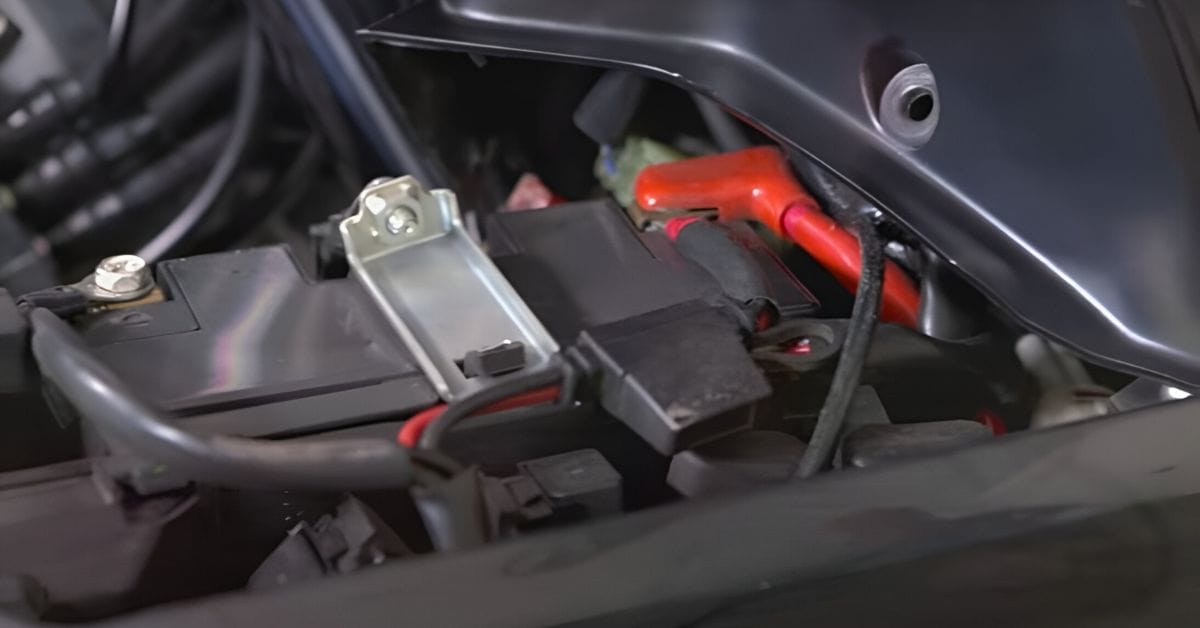
One essential component of any motorcycle is the battery. Without it, your bike won’t start, and you’ll be stuck on the side of the road. But have you ever wondered how many volts your motorcycle battery should have?
Most of the modern motorcycles run on 12-volt batteries. Each of these batteries isn’t just a single unit; it comprises six cells. Each cell carries 2.1 volts, tallying up to about 12.6 volts.
Stick around in this article, as I will break it all down for you. We will look under the motorcycle batteries’ hood (or seat, in this case) and see what makes them tick. Let’s get started!
Understanding Motorcycle Battery Voltages
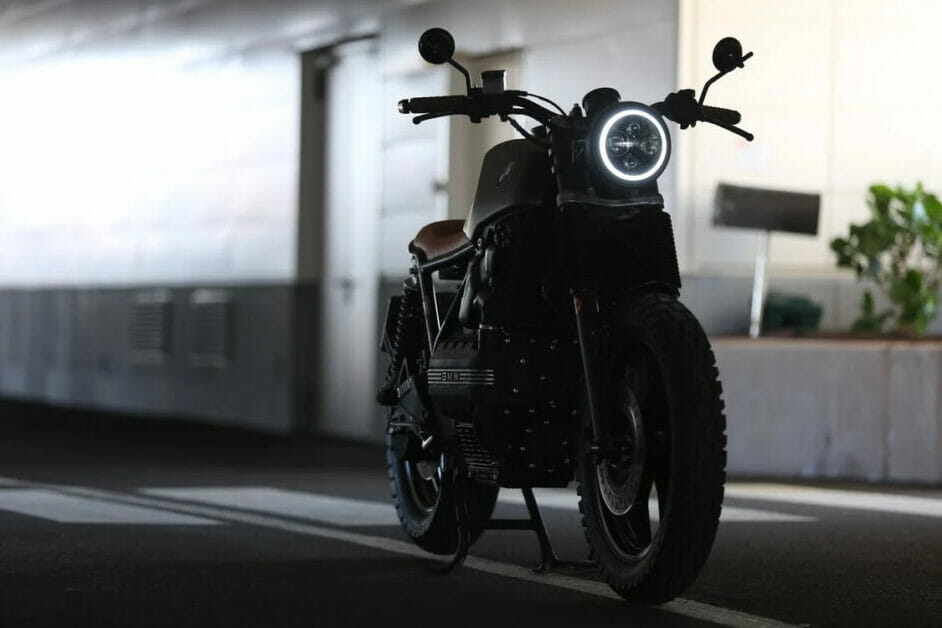
When you look at most motorcycles, you’ll find they run on 12-volt batteries. Don’t be surprised to spot a 6-volt battery on some classic or older models.
A motorcycle battery isn’t just one big block of power. It’s more like a team. In a 12-volt battery, you’ve got six cells, each chipping in with 2.1 volts. Add them all up, and you get around 12.6 volts. On the flip side, a 6-volt battery has three of these cells. Simple math, right?
Now, when talking about a fully juiced-up battery, a 6-volt one should show off around 6.3 volts, while a 12-volt battery should be strutting around with about 12.6 volts.
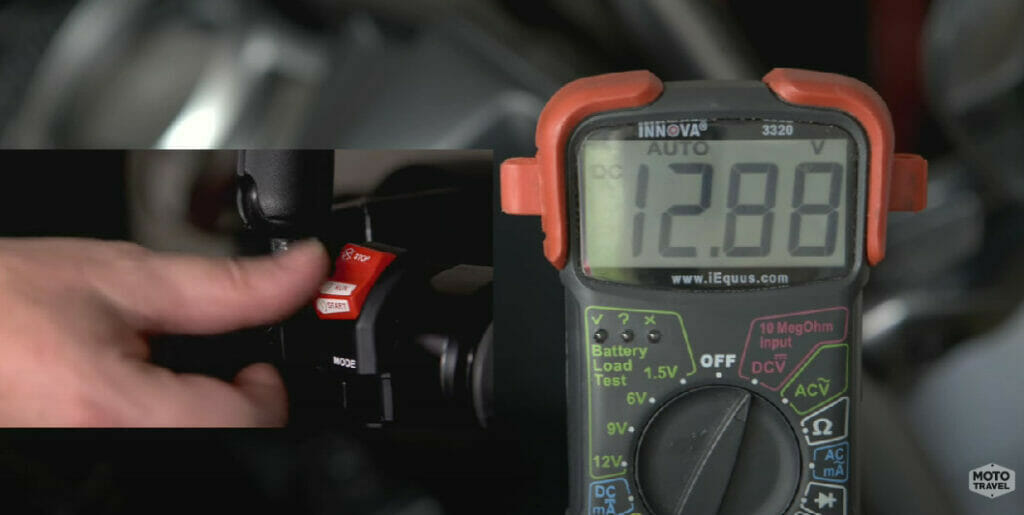
A healthy motorcycle battery should read above 12.20 volts when taking a break. When you fire up your bike, it should be between 9.5v and 10.5v.
Once the engine humbles, anywhere from 12 to 14.5V is in the green zone. But if you see 14.8v or more, whoa there – you’ve got an overcharging situation.
Battery Voltages Across Popular Models
I will list some common motorcycle models and their usual battery voltages to give you an idea.
| Motorcycle Model | Battery Voltage |
|---|---|
| Harley-Davidson Sportster | 12 |
| Honda CB750 | 12 |
| Yamaha R6 | 12 |
| Suzuki GSX-R750 | 12 |
| Kawasaki Ninja 650 | 12 |
| Triumph Bonneville | 12 |
| Honda Super Cub C125 | 6 |
| Yamaha VMAX | 12 |
| Harley-Davidson Softail | 12 |
| Ducati Monster | 12 |
| Honda Grom | 12 |
| BMW R nineT | 12 |
| Honda Rebel 300 | 12 |
| Vespa Primavera | 12 |
| Royal Enfield Classic 350 | 12 |
| Yamaha XT250 | 12 |
| Kawasaki KLR650 | 12 |
| Honda CRF250L | 12 |
| Harley-Davidson Iron 883 | 12 |
| Suzuki DR650S | 12 |
| Yamaha TW200 | 6 |
| Honda Trail 125 | 6 |
Stay tuned because we’re about to get into the nuts and bolts of keeping that battery in shape. Let’s roll!
How to Check the Voltage of a Motorcycle Battery
We’re rolling our sleeves to dive into something crucial for your motorcycle’s health – checking the battery voltage. Trust me, it’s a game-changer for keeping your ride in top shape.
Materials Needed
First things first, let’s grab the tools we need:
- A digital multimeter (your new best friend for this job)
- Safety glasses (because safety is always cool)
- Rubber gloves (to keep those hands safe)
Step-by-Step Guide to Voltage Checking
Alright, let’s get into the nitty-gritty with a step-by-step guide:
Step 1: Find the Battery
Your motorcycle’s battery usually chills under the seat or hangs in a side panel. Find it and give it a friendly nod.
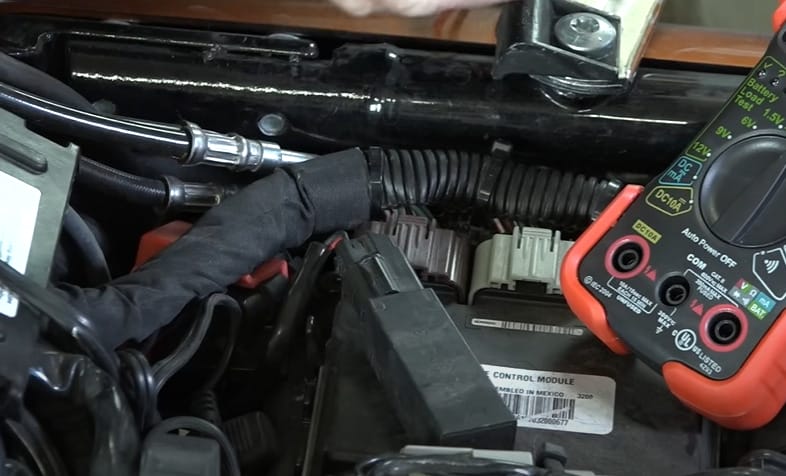
Step 2: Power Down
Ensure your bike is off and the key is out of the ignition. We want everything nice and quiet for this.
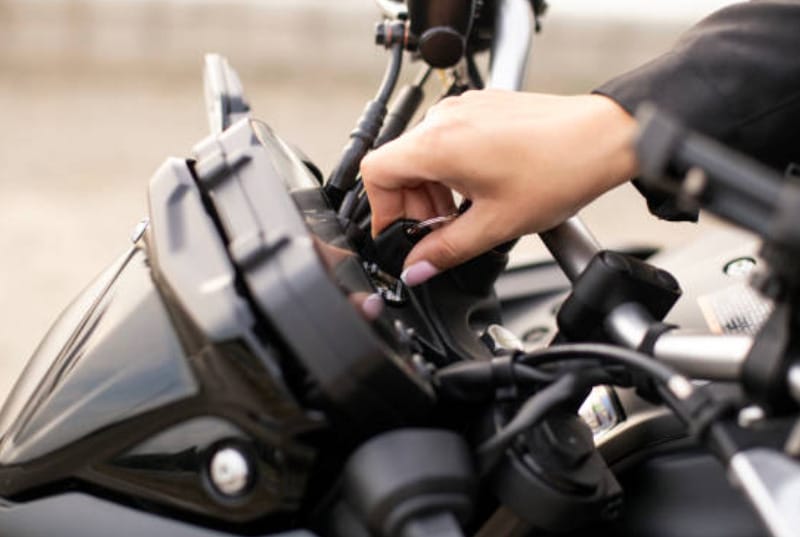
Step 3: Multimeter Time
Grab your digital multimeter and set it to DC voltage mode. It’s about to do some magic.
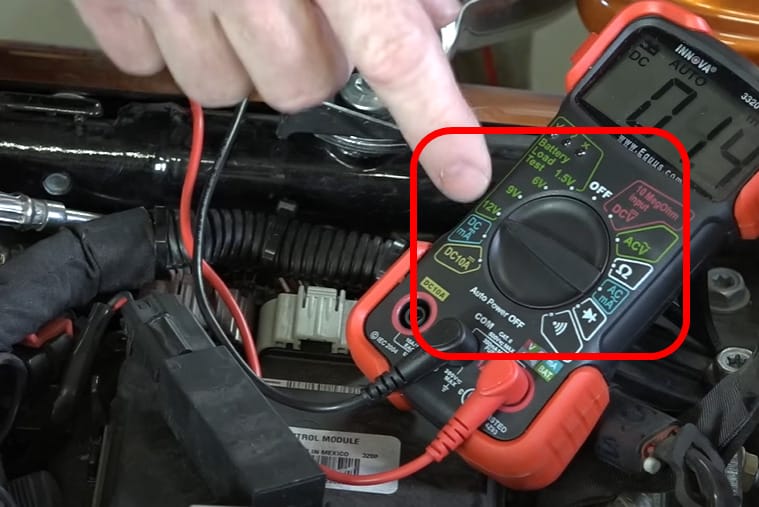
Step 4: Red to Positive, Black to Negative
Connect the red probe of your multimeter to the battery’s positive terminal. Then, take the black probe and introduce it to the negative terminal.
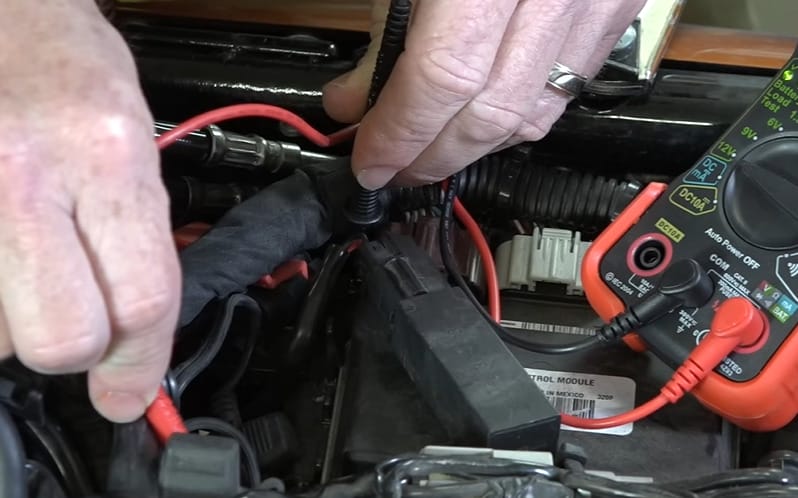
Step 5: Voltage Reading Time
Here’s where the excitement happens. Check the reading on your multimeter. A healthy battery should be strutting above 12.20 volts when just hanging out.
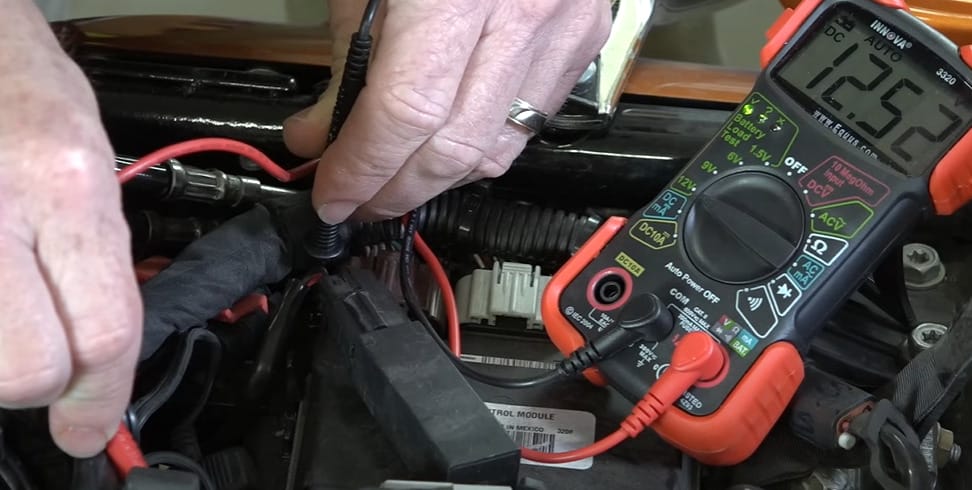
It should be in the cool range of 9.5v to 10.5v on startup. And once your engine is purring, 12 to 14.5V is where it’s at.
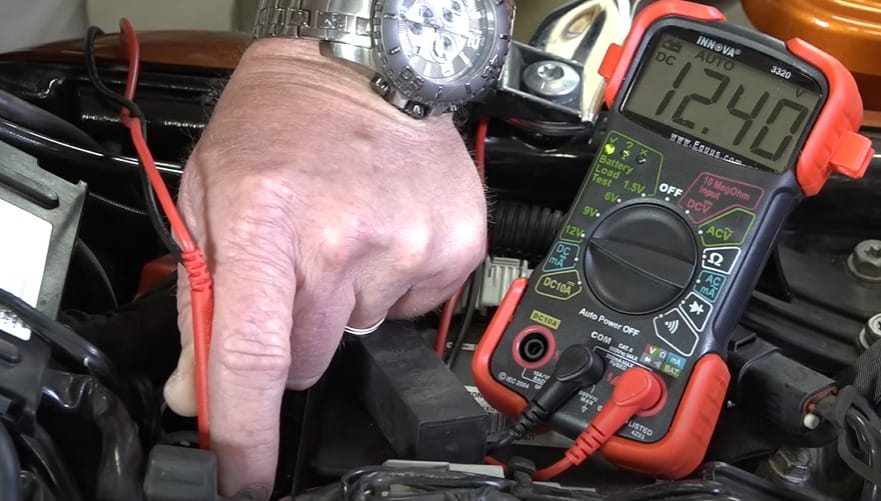
If you’re seeing numbers lower than these, your battery might tell you it’s tired and needs a charge or, in a grumpier scenario, a replacement.
Remember, checking the voltage of your motorcycle battery is a simple task that can save you a lot of trouble down the road.
Spotting the Tell-Tale Signs of a Fading Motorcycle Battery
I will share some insider tips on recognizing when your motorcycle’s battery sings its swan song. Trust me, I’ve been there, and catching these signs early can save you a lot of hassle.
- Slow Engine Start: This is like when your bike seems too lazy to start. If the engine takes longer than usual to start or sounds weak, that’s a sign your battery might be dying.
- Dim Lights: If your bike’s lights are getting dimmer, especially when just idling, it could mean your battery isn’t doing great.
- Dashboard Lights Acting Weird: If the lights on your bike’s dashboard start flickering or acting up, your battery sends an SOS signal.
- Losing Power Suddenly: Have you ever been riding, and your bike feels like running out of steam for no reason? That could be your battery saying it’s had enough.
- Electrical Stuff Not Working Properly: If things like your horn, electric starter, or other electronics aren’t working right, it might be because your battery is getting weak.
- Bulbs Burning Out a Lot: If you’re replacing bulbs more often than usual, it could hint that your battery’s struggling.
- The Bike Just Won’t Start: The most obvious sign is if you turn the key and nothing happens. No sound, no lights, nothing. That’s a pretty clear message: your battery is probably dead.
So, keep an eye out for these things. It’s way better to catch a dying battery early than to get stranded somewhere. Stay safe and happy riding!
Motorcycle Battery Maintenance Schedule: Keeping Your Power Source in Top Shape
Let’s lay out a simple maintenance schedule for your motorcycle battery. Keeping up with this can help extend your battery’s life. Here’s a handy table to keep you on track:
| Timeframe | Maintenance Task |
|---|---|
| Every Ride | – Quick visual inspection of the battery for any obvious damage. |
| – Check the battery terminals to ensure they’re tight and clean. | |
| Monthly | – Test the battery voltage with a multimeter. |
| – Inspect for any signs of corrosion or wear. | |
| Every 3 Months | – Clean the battery terminals. |
| – If it’s a conventional battery, check and maintain fluid levels. | |
| Twice a Year | – Conduct a more detailed inspection of the battery and cables. |
| – Apply dielectric grease to terminals to prevent corrosion. | |
| Annually | – Get the battery professionally tested at a service center. |
| – Consider replacing the battery if it’s over 3 years old or shows signs of wear. |
Remember, regular care can go a long way in keeping your motorcycle battery in great shape. So, print this table out, stick it in your garage, and give your battery the TLC it deserves! Happy riding, folks!
Frequently Asked Questions
- What Does It Mean If My Battery Voltage Is Below 12 Volts?
- If your battery reads below 12 volts, it’s not fully charged. It could mean it’s time for a charge, or the battery might need replacing if charging doesn’t help.
- Do I Need A Special Charger for My Motorcycle Battery?
- It’s best to use a charger designed for motorcycle batteries. These are typically lower in power and voltage compared to car battery chargers.
- How Long Does A Motorcycle Battery Usually Last?
- A well-maintained motorcycle battery can last about 3 to 5 years. But remember that factors like usage and maintenance can affect its lifespan.
- Can Cold Weather Affect My Motorcycle Battery?
- Yes, indeed! Cold weather can reduce your battery’s performance. It’s a good idea to keep your bike in a garage and use a battery tender during winter to maintain the charge.
- Is It Okay To Jump-Start a Motorcycle Battery?
- You can, but do it cautiously. Use a charger or another motorcycle for the jump-start, not a car, as the higher amperage can damage your bike’s electrical system.
References
Organizations:
- Battery Council International (BCI). https://batterycouncil.org/
- International Motorcycle Manufacturers Association (IMMA). https://www.immamotorcycles.org/
Books:
- “The Essential Guide to Motorcycle Maintenance” by Mark Zimmerman. https://www.barnesandnoble.com/w/essential-guide-to-motorcycle-maintenance-mark-zimmerman/1101130609
- “Motorcycle Electrical Systems: Troubleshooting and Repair” by Tracy Martin. https://www.barnesandnoble.com/w/how-to-troubleshoot-repair-and-modify-motorcycle-electrical-systems-tracy-martin/1116912596
Website Resources:
- BatteryStuff.com. https://www.batterystuff.com/
- MotorcycleMD. https://motorcyclemd.com/
- Electrek.co. https://electrek.co/
Video References:
Ryan Urlacher
Moto Travel USA
